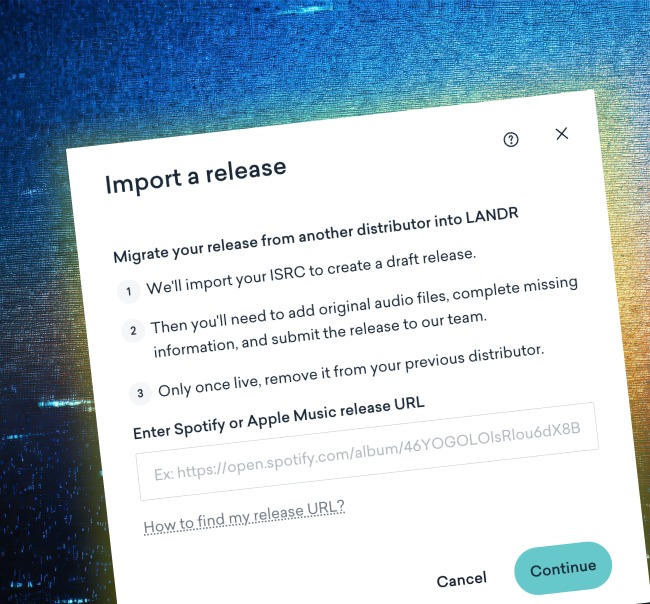
How to Switch Digital Music Distributors
The music distribution landscape is constantly evolving. Today there are countless service providers, each with its own variety of service offerings, pricing and features.
With the amount of choice available, chances are you’ve wondered if you’re getting a good deal, especially if you’ve become dissatisfied with your current provider.
The truth is, music distribution services are a lot like your phone service—if you shop around you might find a better deal with more features and better service.
Switching over really isn’t that hard, even if most music distribution companies would like to make you think it’s a huge, complicated task to move your catalog to a new service provider.
So if you signed up with a distributor years ago and want to change you’re not alone and it’s easier than you think.
Switching over really isn’t that hard, even if most music distribution companies would like to make you think it’s a huge, complicated task.
In this guide, we’ll explore some of the reasons why you might want to switch to a new music distribution service and we’ll go through the various steps you’ll need to make the switch.
By the end, I’m sure you’ll be confident about changing distribution services.
Why switch music distribution services?
There’s a myriad of reasons why you might be interested in switching distribution services.
With a growing range of service providers to choose from there’s probably a better option that suits your needs.
Here’s a handful of specific reasons why you might want to reevaluate your choice of music distribution service.
You have to keep paying to keep your music up
Not all music distribution services are transparent about what happens after you stop paying into their subscription plans.
Sure, some providers may appear to have more attractive prices than others on the surface, but buried in the fine print these services require their users to keep paying to keep their music on streaming services.
I’ve seen online tirades from artists over their frustrations with certain music distributors removing their music because they stopped paying.
Not all music distribution services are transparent about what happens after you stop paying into their subscription plans.
So if you’re concerned about keeping your music up on streaming platforms indefinitely without making a permanent financial commitment, you might want to consider other options or plans.
The features aren’t as deep as other service providers
Not all music distribution services are created equal.
Some focus on offering concierge quality customer service to labels with large catalogs and big-name artists.
On the other side of the spectrum, some distributors focus on offering low-cost services that appeal more to independent artists and casual creators.
But for the serious emerging artist, the best deal you can get is one that bundles distribution services into a larger product—one that includes plugins, samples, mastering and more.
To me, with streaming revenues being slim enough as is, it feels demanding to ask artists to pay to put their music online—it’s better to get distribution as a feature that’s part of a larger service.
🧠 Hot tip
The customer service quality isn’t outstanding
For the low-cost distribution services to survive, they can’t invest in human customer service agents.
For the low-cost distribution services to survive, they can’t invest in human customer service agents.
Instead, you’ll get a chatbot with answer boxes and self-serve help. If you do have a question, you’ll maybe get an answer in your inbox days later.
Releasing music is stressful enough and having to deal with technical issues without any kind of responsive human interaction only makes things worse.
You don’t have the option to keep 100% of your streaming revenue
Perhaps worst of all—if you don’t want your distribution service to take a cut of your streaming revenue, you should have this choice.
You’ve already paid them to get your music on Spotify and Apple Music, don’t let them take the money you’ve earned from that investment.
Instead, stick to a distribution service that gives you the option to keep 100% of your streaming revenues and guarantee that you get every dollar that you’ve earned.
🧠 Hot tip
How to switch digital music distributors in 5 steps
Alright now that you know some of the red flags to watch for, here’s how to actually make switching music distributors a reality.
1. Use LANDR’s new migration tool
LANDR is making it easier than ever to migrate your music catalogue onto its music distribution service.
The process is simple, copy any Spotify or Apple Music URL where your albums, EPs or singles are found and LANDR will automatically populate its release tool with all the needed identifiers to effectively transfer your music.
The tool automatically finds pertinent information, specifically grabbing the ISRC codes for each track in your catalogue.
It’ll also grab release year, album and song names so you don’t have to fill any of that in.
Once the tool does its job, you’ll have to fill in all the relevant information about the release including songwriter, producer names and upload your original .WAV master files.
Once you’ve submitted the release, sit back and let LANDR do it’s thing.
Don’t take your release down on the music distribution service you’re leaving until the release is live on LANDR Distribution.
2. Export your data
If you’re not using LANDR’s migration tool, you’ll have to do a little bit of work.
First, let’s make sure you have all the data you need to switch over.
Your distribution service provider may or may not allow you to do a bulk export of your catalog’s data.
If you can export everything, great! That’s going to make switching super easy, just copy and paste all the important information into the template and start adding it into your new platform.
If you can’t export your metadata, no worries.
Put on some ambient music and copy and paste each song’s information into your spreadsheet—you should be able to find all the information for each song when you login to your service provider’s platform.
Here’s the specific details you need to grab:
- Primary artist
- Featured artist
- Composer(s)
- Producer(s)
- Album titles
- Song titles
- Year of release
- ISRC
3. Double-check your ISRC codes and metadata
To make a smooth transition you must submit identical metadata and ISRC codes.
Your unique ISRC codes are used by streaming services to identify your tracks and pay out streaming royalties—so getting them right is important.
If you don’t know how to get or find your ISRC codes, we’ve written about them in past articles.
Metadata includes your artist name, song titles, release date, release type (album, EP, single) and artwork—they must be the exact same.
So make sure everything is properly formatted before you upload your information to the new provider.
4. Upload the exact same audio files
Now that you have the data formatted and ready to go, it’s time for the main event—your audio.
Sadly, you can’t upload a new version of your song and have it transition properly.
You must upload the exact same audio file of your original release to switch distributors.
So grab that original master file and upload your original track.
5. Set the release live and don’t panic
Alright, you diligently exported your data, codes and other information.
Then you filled out your information and uploaded music to your new distribution service.
Great work! The hard part is done.
Set the release live and wait for it to hit distribution stores.
But, don’t cancel your plan or issue a takedown notice right away.
Things might look weird for a second since you’ll need to wait for your tracks to hit the streaming platforms—for a time, you’ll have the same release live as two different releases. Don’t worry this is totally normal.
Now that your release is live on the new distribution platform it will be “merged” on the streaming platform, it will show as one release as it originally was.
Once the release is merged, you’ll be able to issue a takedown notice and cancel your plan with your old distributor.
Congrats, you successfully switched music distributors!
Get more out of your music distribution plan
Don’t let a music distribution service hold you hostage financially, demand your streaming revenues or stress you out with bad customer service.
If you’re not happy with the distribution service you currently work with, there’s totally a way out.
Just follow this simple guide, check out our handy spreadsheet template and stay cool, calm and collected.
You’ll be on your way to sunny days and success on the streaming platforms in no time.
Good luck!
Gear guides, tips, tutorials, inspiration and more—delivered weekly.
Keep up with the LANDR Blog.



